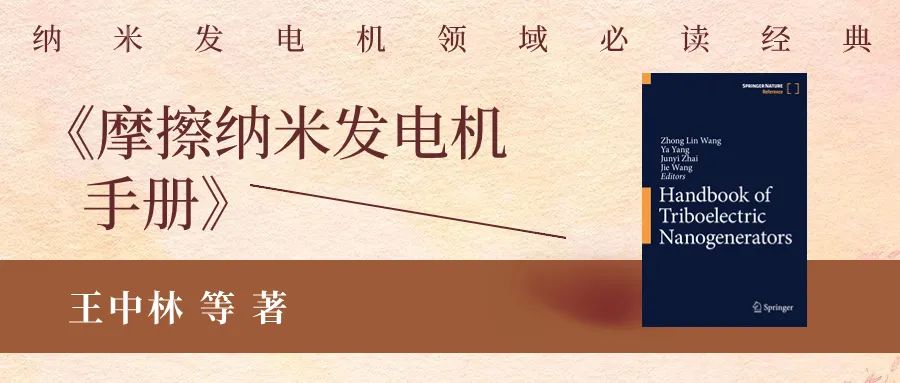
Hand-book of Triboelectric Nanogenerator
Zhong Lin Wang1, Ya Yang1, Junyi Zhai1, Jie Wang1
1.Beijing Institute of Nano energy and Nano systems, University of Chinese Academy of Sciences
背景介绍
2012年,王中林院士团队首次发明了摩擦纳米发电机(TENG),标志着一个关于能量收集和自驱动传感的全新领域拉开序幕。基于接触起电和静电感应原理的摩擦纳米发电机,可以高效收集人们周围分布广泛且无处不在的机械能,为自驱动系统、未来能源的可用技术以及高熵能量的利用提供了范式。
摩擦纳米发电机的发明,不仅吸引了来自全球83个国家和地区的12000多名科学家对接触起电以及对麦克斯韦方程组的扩展等基础科学问题的深入研究,还为医学、可穿戴电子器件、基础设施监控、安全、环境科学、物联网(IoT)和机器人等应用领域提供了全新的应用技术。
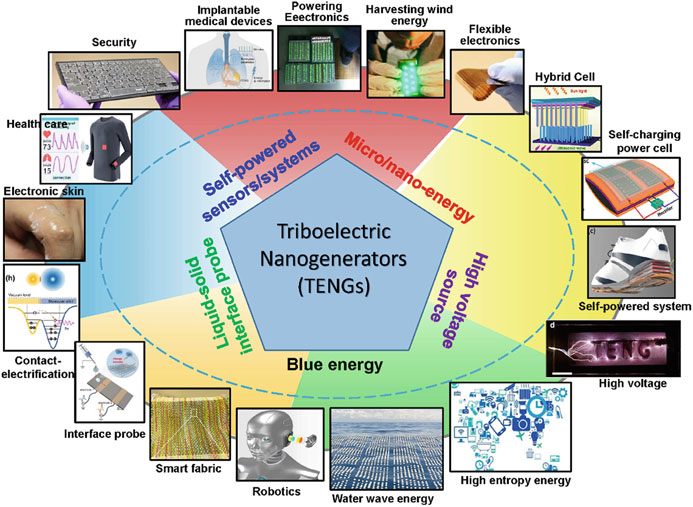
图1、TENG五大应用领域,包含柔性电子、人机界面、机器人、可穿戴电子医疗科学、环境科学、国防和蓝色能源等。
总序
Triboelectric Nanogenerator(《摩擦纳米发电机》)是王中林院士团队于2016年出版的第一本用于系统介绍摩擦纳米发电机的教科书。
纳米发电机:书籍推荐|看摩擦纳米发电机如何走上 “书架子”
科学出版社:一部《摩擦纳米发电机》带您了解终身科学影响力排名世界第5位的王中林院士创新工作!
科学出版社:王中林:摩擦纳米发电机
然而,由于这一领域的快速发展,许多具有突破性进展的科学研究并未收录在内。因此,有必要出版该书的第二个版本,为科学家、教育工作者和学生提供关于以摩擦纳米发电机为主的最新进展的详细概述。在此,王中林院士联合来自9个国家和地区的90多位世界顶尖学者共同撰写并编辑了一套Hand-book of Triboelectric Nanogenerator(《摩擦纳米发电机手册》),全面涵盖了摩擦纳米发电机的基础科学、技术应用、材料开发和潜在的商业应用价值。
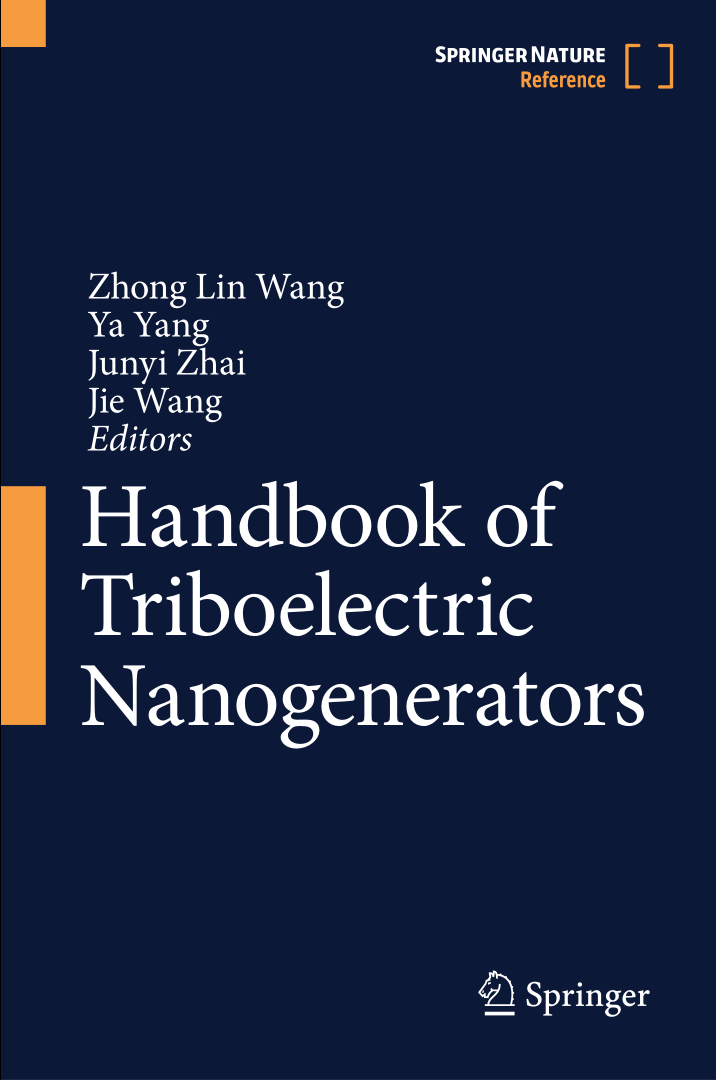
该手册共分为四卷,包含五十三个章节。第一卷介绍了摩擦纳米发电机的基本原理,包括固体-固体接触起电的原理、液体-固体接触起电的原理、位移电流理论、摩擦纳米发电机的基础特性以及关于摩擦纳米发电机的定量化计算方法。第二卷介绍了摩擦纳米发电机作为微/纳能源的应用,包括医疗保健、可穿戴电子和物联网(IoT)等重要领域。第三卷介绍了摩擦纳米发电机用于收集蓝色能源和环境中的能量,包括水滴能、风能和声能。第四卷介绍了摩擦纳米发电机作为传感器和高压电源的具体应用,如光学传感、人工智能、智能家居传感、交互式神经和电子皮肤,并重点介绍了这些先进技术的最新发展。
该手册的每一章节都由摩擦纳米发电机研究领域的专家撰写,具有很高的学术水准。这些卷整合在一起将成为摩擦纳米发电机领域的重要参考书目。它可以作为工具书,促进摩擦纳米发电机的基础研究和实际应用,为从事该领域的科学家、教育工作者和对摩擦纳米发电机研究感兴趣的学生提供广泛且精确的参考。
书籍原文链接:
https://link.springer.com/referencework/10.1007/978-3-031-05722-9
关注"纳米能源所"微信公众号后台回复“TENG”即可获取该出版社书籍链接。
文末附书籍中文目录。
第一卷
Fundamentals of Triboelectric Nanogenerators
摩擦纳米发电机的基本原理
第一卷简介:
基于摩擦起电和静电感应原理的摩擦纳米发电机(TENG),可以将环境中的机械能高效地转化为电能。摩擦纳米发电机既不是磁铁,也不是线圈。它质量轻、密度低、成本低,大多数有机材料都可以用于制造TENG。最重要的是,与传统的电磁发电机相比,摩擦纳米发电机的工作频率非常低(<5–10 Hz);因此,它是从身体运动和海浪中获取低频能量的最佳选择。此外它还可以作为一种自供电传感器,用于机械传感器、生理检测、运动传感、人机交互和电子皮肤技术等应用。更重要的是,摩擦纳米发电机的发明不仅为能量收集和自驱动传感领域开辟了一个新的方向,还促进了固-固界面的接触起电、固-液界面的接触起电以及麦克斯韦方程组的扩展等一系列基础科学问题的深入研究。同时,研究者们提出了适用于摩擦纳米发电机结构参数优化的计算方法以及摩擦纳米发电机性能评定的标准(品质因数),在此基础上,摩擦纳米发电机的性能优化,能量存储,电源管理系统等问题也取得了重大进展。
章节目录:
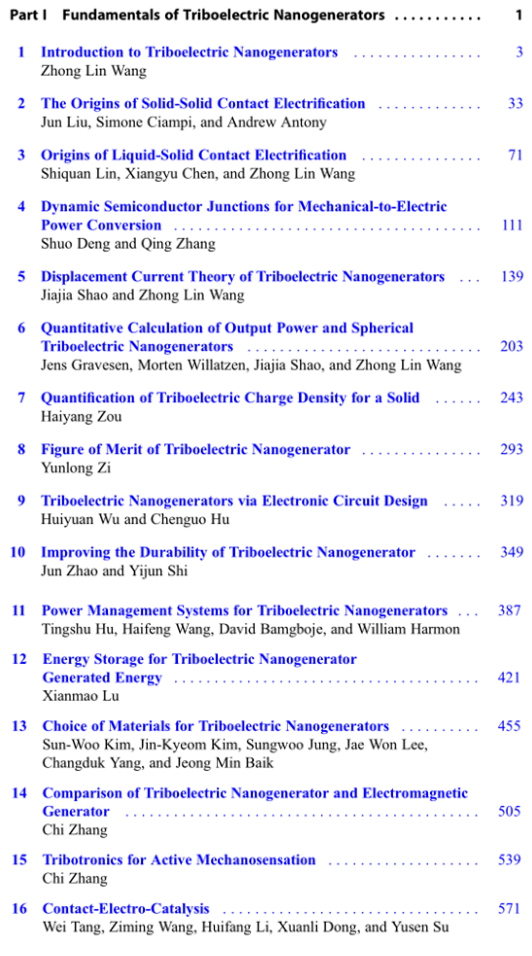
第二卷
Triboelectric Nanogenerators as Micro-nano Power Sources
摩擦纳米发电机作为微/纳能源的应用
第二卷简介:
随着人类社会逐渐进入以物联网、传感网络、大数据、机器人和人工智能等为代表的新时代,数以万亿且广泛分布的电子器件对能源的需求和能源结构提出了新的挑战。摩擦纳米发电机具有质量轻、体积小、材料选择广泛、结构简单、易安装、免维护等特点,其多样化的工作模式可以适应不同的工作场景,这使得其可以作为微/纳能源,将生物体和环境中的机械能转换成电能,为新时代的能源需求提供可靠的解决方案。尤其在低频机械能收集方面,摩擦纳米发电机已经表现出独特优势,其具有更高的能量转换效率,在植入式医疗、可穿戴电子以及物联网器件的供能等方面展现出巨大的潜力,被成功用于自驱动心脏起搏器、自驱动电子皮肤、智能纺织品、自驱动电化学污染物治理、自驱动桥梁监测系统等。基于摩擦纳米发电机实现电子器件的自驱动化可以摆脱电源的制约,为新时代分布式电子器件的供能提供新的范式,是物联网发展微小集成化,无线移动化,功能智能化的重要技术支撑。
章节目录:
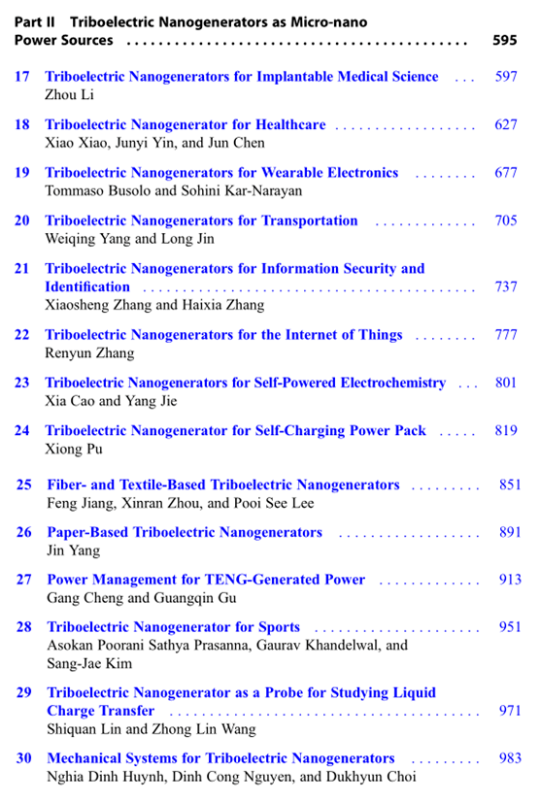
第三卷
Triboelectric Nanogenerators for Blue Energy and Environment
摩擦纳米发电机用于收集蓝色能源和环境中能量
第三卷简介:
摩擦纳米发电机结构简单、机械能收集效率高,在收集环境机械能(如海洋能、风能、水滴能等)方面展现出独有的优势。其中海洋覆盖了地球70%以上的表面,蕴藏着丰富且清洁的可再生能源,足以满足人类现有的能源需求。海洋能源若能实现大规模商业化利用,将极大缓解人类能源供需的紧张形势,带来能源格局的巨大变化。2014年王中林院士提出的基于摩擦纳米发电机的海洋蓝色能源技术,为实现这一目标提供了一条可行的技术途径。与传统的海洋能开发技术相比,由位移电流所驱动的摩擦纳米发电机对低频机械能响应高,可以高效收集低频且无序的海洋能。而且,由摩擦纳米发电机单元组成的海洋能收集网络,令该技术路径在器件结构设计和材料选择方面有很高的灵活性。此外单个器件结构简单、成本低,无需复杂的机械结构就可以产生极高的功率输出。基于摩擦纳米发电网络的技术路径有可能解决海洋能源利用的重大课题,具有成为新兴战略前沿方向的潜力,为打造智慧海洋提供技术支撑和应用示范。
章节目录:
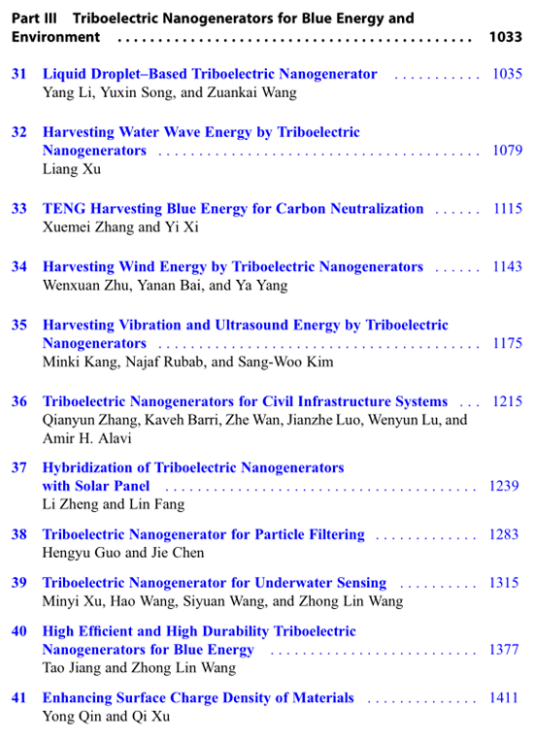
第四卷
Triboelectric Nanogenerators as Sensors and High Voltage Sources
摩擦纳米发电机作为传感器和高压电源的应用
第四卷简介:
摩擦纳米发电机可以在机械激励下直接产生电信号,其输出信号能很好地反映机械激励变化,且对各种形式的机械运动均具备较好的适应性。因此,摩擦纳米发电机不但可用于微/纳能源收集,还可以作为一种实现自供能的新型传感技术手段。摩擦电式传感器具有多形态、低成本的优势,在人体运动/健康、生物医疗、人机交互、环境监测及基础设施安全等领域展现出广阔的应用前景。此外,摩擦纳米发电机的高电压、低电流特性使其可以作为新型的高压电源,并具有前所未有的便携性和安全性。基于摩擦纳米发电机的新型高压源通常不需要复杂的电源转换器,可以极大的简化整个系统,且较低的电流对人员和仪器安全的威胁较小,在大幅减小高压电源体积的前提下,兼具轻巧、实用、方便且高效的优点。基于摩擦纳米发电机的高压电源在自驱动静电纺丝、微流泵、微流控、微等离子体激发以及静电驱动等方面应用潜力巨大。开发基于摩擦纳米发电机的新型高压源可以满足电子设备小型化、高效化和高性能化的新时代需求。
章节目录:
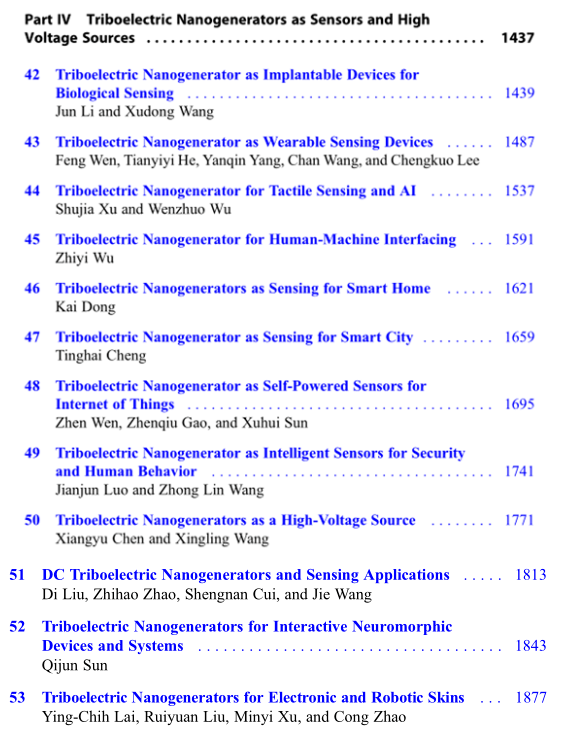
全文中文目录
1. Introduction to Triboelectric Nanogenerators
(摩擦纳米发电机简介)
2. The Origins of Solid-Solid Contact Electrification
(固-固接触起电的来源)
3. Origins of Liquid-Solid Contact Electrification
(液-固接触起电的来源)
4. Dynamic Semiconductor Junctions for Mechanical-to-Electric Power Conversion.
(动态半导体结用于机电能量转换)
5. Displacement Current Theory of Triboelectric Nanogenerators
(摩擦纳米发电机的位移电流理论)
6. Quantitative Calculation of Output Power and Spherical Triboelectric Nanogenerators
(定量计算球形摩擦纳米发电机的输出功率)
7. Quantification of Triboelectric Charge Density for a Solid.
(固体材料的摩擦电荷密度量化)
8. Figure of Merit of Triboelectric Nanogenerator.
(摩擦纳米发电机的品质因素)
9. Triboelectric Nanogenerators via Electronic Circuit Design.
(摩擦纳米发电机的电子电路设计)
10. Improving the Durability of Triboelectric Nanogenerator.
(摩擦纳米发电机的稳定性提升)
11. Power Management Systems for Triboelectric Nanogenerators.
(摩擦纳米发电机的功率管理系统)
12. Energy Storage for Triboelectric Nanogenerator Generated Energy.
(摩擦纳米发电机的电能存储)
13. Choice of Materials for Triboelectric Nanogenerators.
(摩擦纳米发电机的材料选择)
14. Comparison of Triboelectric Nanogenerator and Electromagnetic Generator.
(摩擦纳米发电机与电磁发电机的比较)
15. Tribotronics for Active Mechanosensation.
(摩擦电子学及主动式机械感知)
16. Contact-Electro-Catalysis.
(接触电致催化)
17. Triboelectric Nanogenerators for Implantable Medical Science.
(摩擦纳米发电机用于植入式医疗)
18. Triboelectric Nanogenerator for Healthcare.
(摩擦纳米发电机用于医疗健康保健)
19. Triboelectric Nanogenerators for Wearable Electronics.
(摩擦纳米发电机用于可穿戴电子器件)
20. Triboelectric Nanogenerators for Transportation.
(摩擦纳米发电机用于交通运输)
21. Triboelectric Nanogenerators for Information Security and Identification.
(摩擦纳米发电机用于信息安全和信息识别)
22. Triboelectric Nanogenerators for the Internet of Things.
(摩擦纳米发电机用于物联网)
23. Triboelectric Nanogenerators for Self-Powered Electrochemistry.
(摩擦纳米发电机用于自驱动电化学)
24. Triboelectric Nanogenerator for Self-Charging Power Pack.
(摩擦纳米发电机用于自充电电源)
25. Fiber-and Textile-Based Triboelectric Nanogenerators.
(基于纤维和纺织品的摩擦纳米发电机)
26. Paper-Based Triboelectric Nanogenerators.
(纸基摩擦纳米发电机)
27. Power Management for TENG-Generated Power.
(摩擦纳米发电机的电源管理)
28. Triboelectric Nanogenerator for Sports.
(摩擦纳米发电机用于运动)
29. Triboelectric Nanogenerator as a Probe for Studying Liquid Charge Transfer.
(摩擦纳米发电机作为探针探究液体电荷转移)
30. Mechanical Systems for Triboelectric Nanogenerators.
(用于摩擦纳米发电机的机械系统)
31. Liquid Droplet–Based Triboelectric Nanogenerator.
(基于液滴的摩擦纳米发电机)
32. Harvesting Water Wave Energy by Triboelectric Nanogenerators.
(摩擦纳米发电机收集水波能)
33. TENG Harvesting Blue Energy for Carbon Neutralization.
(摩擦纳米发电机收集蓝色能源用于碳中和)
34. Harvesting Wind Energy by Triboelectric Nanogenerators.
(摩擦纳米发电机收集风能)
35. Harvesting Vibration and Ultrasound Energy by Triboelectric Nanogenerators.
(摩擦纳米发电机收集振动和超声能量)
36. Triboelectric Nanogenerators for Civil Infrastructure Systems.
(摩擦纳米发电机用于民用基础设施系统)
37. Hybridization of Triboelectric Nanogenerators with Solar Panel.
(摩擦纳米发电机和太阳能电池的耦合)
38. Triboelectric Nanogenerator for Particle Filtering.
(摩擦纳米发电机用于颗粒过滤)
39. Triboelectric Nanogenerator for Underwater Sensing.
(摩擦纳米发电机用于水下传感)
40. High Efficient and High Durability Triboelectric Nanogenerators for Blue Energy.
(高效、高稳定性的摩擦纳米发电机用于蓝色能源)
41. Enhancing Surface Charge Density of Materials.
(提高材料的表面电荷密度)
42. Triboelectric Nanogeneratoras Implantable Devices for Biological Sensing.
(植入式摩擦纳米发电机用于生物传感)
43. Triboelectric Nanogeneratoras Wearable Sensing Devices.
(基于摩擦纳米发电机的可穿戴传感装置)
44. Triboelectric Nanogenerator for Tactile Sensing and AI.
(摩擦纳米发电机用于触觉传感和人工智能)
45. Triboelectric Nanogenerator for Human-Machine Interfacing.
(摩擦纳米发电机用于人机接口)
46. Triboelectric Nanogenerators as Sensing for Smart Home.
(摩擦纳米发电机用于智能家居的传感技术)
47. Triboelectric Nanogenerator as Sensing for Smart City.
(摩擦纳米发电机用于智慧城市的传感技术)
48. Triboelectric Nanogenerator as Self-Powered Sensors for Internet of Things.
(摩擦纳米发电机作为自供电传感器用于物联网)
49. Triboelectric Nanogenerator as Intelligent Sensors for Security and Human Behavior.
(摩擦纳米发电机作为智能传感器用于安全和人类行为监测)
50. Triboelectric Nanogenerators as a High-Voltage Source.
(摩擦纳米发电机作为高压电源)
51. DC Triboelectric Nanogenerators and Sensing Applications.
(直流摩擦纳米发电机及其传感应用)
52. Triboelectric Nanogenerators for Interactive Neuromorphic Devices and Systems.
(摩擦纳米发电机用于交互神经形态器件及系统)
53. Triboelectric Nanogenerators for Electronic and Robotic Skins.
(摩擦纳米发电机用于电子皮肤和机器人皮肤)
作者简介
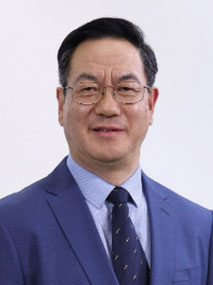
Zhong Lin Wang is the Director of the Beijing Institute of Nanoenergy and Nanosystems, and Regents Professor and Hightower Chair at Georgia Institute of Technology. Dr. Wang pioneered the nanogenerators field ford is tributed energy, self-powered sensors, and large-scale blue energy. He coined the fields of piezotronics and piezo-phototronics for the third-generation semiconductors. Among 100,000 scientists across all fields worldwide, Wang is ranked #3 in career scientific impact, and #1 in Materials Science. Dr. Wang has received the Celsius Lecture Laureate, Uppsala University, Sweden (2020); The Albert Einstein World Award of Science (2019); Diels-Planck lecture award (2019); ENI award in Energy Frontiers (2018); The James C. McGroddy Prize in New Materials from American Physical Society (2014); and MRS Medal from Materials Research Society (2011). Dr. Wang was elected as a fellow of the US National Academy of Inventors in 2022, foreign member of the Chinese Academy of Sciences in 2009, member of European Academy of Sciences in 2002, academician of Academia of Sinica 2018, and International fellow of Canadian Academy of Engineering 2019. Dr. Wang is the founding editor and chief editor of an international journal Nano Energy.
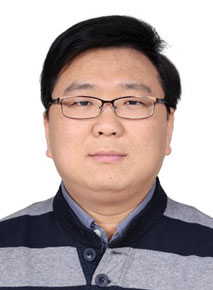
Ya Yang is a Professor at the Beijing Institute of Nanoenergy and Nanosystems, Chinese Academy of Sciences. He has developed various new hybridized and multi-effects coupled nanoenergy-related materials and devices, opening up the new principles of the device design and coupled effects, and the new approaches of improving output performances of nanoenergy-related devices. His main research interests focus on hybridized and coupled nanogenerators, self-powered sensors, other energy-scavenging devices, and some new physical effects. He has published more than 200 SCI academic papers in top journals, which have been cited by more than 19,000 times, and the corresponding H-index is 83 (web of science). He has served as the session chairman of the international academic conferences for six times, and he is the editor-in-chief of Nanoenergy Advances, and the editorial committee member of InfoMat, Nano-Micro Letters, Nanoscale, Nanoscale Advances, iScience, and some other journals.
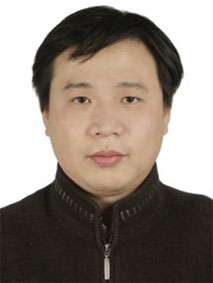
Junyi Zhai is a Professor at the Beijing Institute of Nanoenergy and Nanosystems, Chinese Academy of Sciences. His research mainly engaged in the preparation of piezoelectric semiconductor materials, the growth and characterization of epitaxial functional oxides, the design and application of novel multi-functional electronics and optoelectronics devices, self-powered sensors, and the Ocean Internet of Things. So far, he has published more than 150 research papers in journals such as Science Advances, Nature Communication, Matter, Chemical Review, and Advanced Materials, withover 10,000 citations. The H-index of these papers is 52, and he has obtained 10 invention patents. He has been a PI or Co-Pi for five projects from the National Natural Science Foundation of China and the Ministry of Science and Technology of the People’s Republic of China.
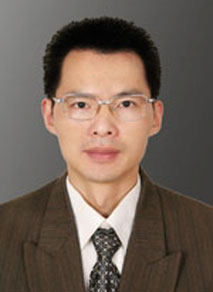
Jie Wang received his B.Eng. degrees from the Department of Polymer Science and Engineering and the Department of Computer Science and Technology at Xi’an Jiaotong University in 2000. He received his Ph.D. degree from the Department of Electronics Science and Technology at Xi’an Jiaotong University in2008. Dr. Wang joined the Beijing Institute of Nanoenergy and Nanosystems, Chinese Academy of Sciences as a Professor in 2016. His current research interests mainly focus on triboelectric nanogenerators, high-entropy energy, self-powered sensors, and self-powered system. He has authored over 130 peer-reviewed journal articles (13 in Nature/Science sister journals, H-index 56), and holds over 30 patents. He was honored as the New Century Excellent Talents in University, China.

